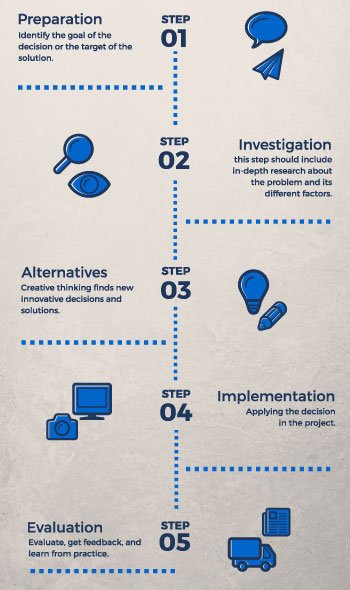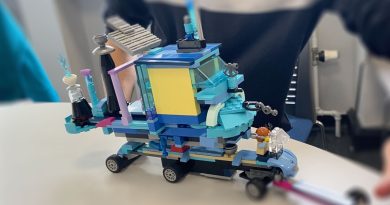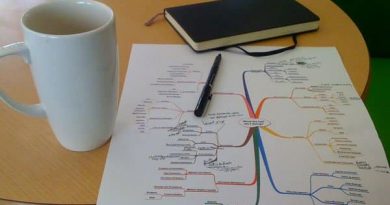Five Steps to Achieve a Reliable Decision-Making Process
Decision making has never been an easy process for designers. A designer’s daily work involves taking many decisions that can affect the whole project starting from communicating with the client needs and requirements, choosing the materials and design specification for the production process, and getting feedback and evaluation concerning the final product. Wrong decisions taken in the design process affect the rest of the project badly. Therefore, designers should be able to make critical decisions in the time of crisis.
As part of the project, stakeholders and the design team contribute with the executive team to make decisions. However, the decision-making process extends to junior and senior designers in team due to the creative nature of the design process. While designers use their creativity to build ideas and designs, this qualifies them to be part of the decision-making process. The decision-making process becomes more challenging for designers if they do not have the proper knowledge or experience, they either risk making the wrong decision or sometimes will be excluded from the decision making process.
Note: The infographic associated with this article can be dowloaded in high resolution by clicking here.
Type of Decisions
Decisions faced during the daily work routine vary based on type and complexity. In order to understand the different scenarios of problems that may face designers when making decision, five types of problems can be highlighted and considered while making decisions:
- Uncertainty – there is not enough information about the situation leaving the designer uncertain which is the best decisions to make.
- Complex – there are many factors, information, and scenarios involved with the decision. This complexity makes it harder for designers to determine the right decision.
- High-risk – the impact of the decision may be high risk or have negative reflections on the project flow. The risky nature of the decision may halt the designer from making the right decision due to confusion or fear of failure.
- Alternatives – various alternatives increase the confusion about which is the right decision to make. People feel confused when faced with multiple choices instead of relatively few options to choose from.
- Interpersonal – the decision involves multiple stakeholders and the designer needs to evaluate how the decision will affect other people. Increasing the number of persons involved in the problem requires the process to be evaluated and decision to be taken with considering all the parties involved in the problem.
The first step in making a proper decision is to evaluate the decision or the problem based on the types above. Categorizing the problem highlights many of the factors related to it and subsequently determine the right steps on the way to selecting the right decision. In some cases the decision fall under two or more types based on the situation, this increase the complexity of the problem requiring more experience, time, brainstorming, and effort to solve it.
Achieve Reliable Decision Making Process
Many decisions fail to achieve their target and puts the project in risk due to the wrong evaluation of the problem or the team may be following a nonsystematic decision making process. The decision-making process involves a number of steps that ensure every aspect of the problem is covered and all the factors are considered during the decision making process.

Step 1: Preparation
The first step to make a decision is to identify the goal of the decision itself. Many decision makers fail to make a decision because they miss their target and don’t really know what they want in the first place. Before making a decision about changing the printing medium, the designer should ask why do we want to change the medium? Or what is the target of changing the printing medium? Clarifying the target ensures that the right problem is addressed in the decision-making process. Clarifying the target involves eliminating the wrong problem or the unwanted factors that may affect decision-making. Focusing on the correct problem and clarifying the target contributes to eliminating other problems.
The preparation stage involves determining if the problem will be solved by one decision maker or involve a group. In many design-related projects, a number of stakeholders are involved in the decision making process. The preliminary discussion requires time and effort, so it can include, exclude or involve memberson a limited scale if the decision needs to be made very quickly. For example, the group discussion may include the executive stakeholders instead of the whole team. A number of methods ensure that the group discussion is effective enough to achieve the desired target such as the Stepladder technique. In this method the discussion start with sharing ideas between two of the stakeholders. Then, a third person join the meeting and start to share the ideas before the three of them share that ideas reached in the first two person discussion. Then, a fourth person join the meeting to repeat the steps with the third person…etc.
At the early stage of facing the problem, gut instincts and intuition play an essential role in solving the problem. This talent can be achieved through a number of intersecting factors such as the previous experience and leadership skills of those involved.
Step 2: Investigation
After setting up the target and preparing the methods and a team will be involved in the decision-making process, the investigation step should include in-depth research about the problem and its different factors. In this step, the problem is investigated within the context of finding the right solution and reaching the best decision. In this step, the team collects all the possible information about the problem.
Different methods can be used to ensure researching the different sides of the problem including the SCAMPER technique, which is an acronym for seven techniques; (S) substitute, (C) combine, (A) adapt, (M) modify, (P) put to another use, (E) eliminate and (R) reverse. In addition, the team can employ the CATWOE technique, which aims to investigate the problem using the following six factors:
- Clients: who are the beneficiaries or victims of this particular system?
- Actors: who are responsible for implementing this system?
- Transformation: what transformation does this system bring about?
- Worldview: what particular worldview justifies the existence of this system?
- Owner: who has the authority to abolish this system or change its measures of performance?
- Environmental constraints: which external constraints does this system take as a given?
Step 3: Generating Alternatives
In this step, creative thinking starts to be part of the process. In order to reach innovative decisions or solutions for problems creative thinking should be utilized. We have discussed many creative thinking methods and approaches such as the following:
- TRIZ method for problem solving
- Mind mapping
- Hudson’s Production thinking model
- Disney’s Creative Strategy
- Reverse Brainstorming
- The Six Thinking Hats
- Lego Serious Play
The target of these methods is to reach a number of alternative decision options based on a number of methods and techniques proven to reach innovative solutions. The results can be filtered in later steps.
Step 4: Selection and Implementation
At this stage, the decision-making team has generated a number of innovative solutions that can be formed in selecting a final decision. These solutions are evaluated and the best solutions should be selected. Limiting the number of options should result in a fewer number of decisions to take. These decisions can be filtered to reach the best decision using many methods such as the SWOT analysis. This method aims to evaluate the solution based on four factors; strength, weakness, opportunity, and threat based on intrinsic and extrinsic factors.
At the end of the selection step, the final decision should be reformed and be ready to be announced. This decision is tailored to achieve the target goal identified at the beginning of the decision making process.
Step 5: Evaluation
Applying the decision should be followed by a follow up stage to evaluate the implementation for the selected decision and how the process contributes in reaching the best decisions. The evolved results of the process should be applied in the following decision making experience. This evaluation can involve replacing one of the methods or adding people to the decision-making process.
One of the common mistakes occurs when the decision maker applies the same process again and again without evaluating the results or customizing the decision-making process based on each project’s success, timing and circumstances.
Make a Quick Decision
In the quick decision making process, the steps above may seem unrealistic. In many cases, the decision have to be taken during a meeting or a phone call. Decision makers do not have the luxury to apply or time to take the above steps or even consult the team about the decision. Therefore, a quick route should be taken. For example, excluding the group meeting or limiting it can reduce the decision-making time. Also, depending on previous experience or similar decisions can reduce the investigation and selection time. Following the decision makers gut instincts and intuition can contribute to reducing the decision time. This is considered one of the leadership skills that differentiate between ordinary and talented leaders.
Conclusion
Designers should be able to solve problems not only on the initial design level, but also during brainstorming and production stages as part of the stakeholder’s team. While some designers lack the experience to make critical decisions, a number of tips and methods can be used to ensure reaching the best decision. Learning from previous decisions and projects plays an essential role in building a rationale towards an effective decision making experience.
The steps above are used in many normal decision-making processes. However, most of the tasks require quick decision-making. Therefore, excluding members or shortening the time required to achieve each step may be required to reduce the decision making process time. Additionally, instinct and intuition as well as previous experience plays an essential role in making the best decision in a shorter time.






